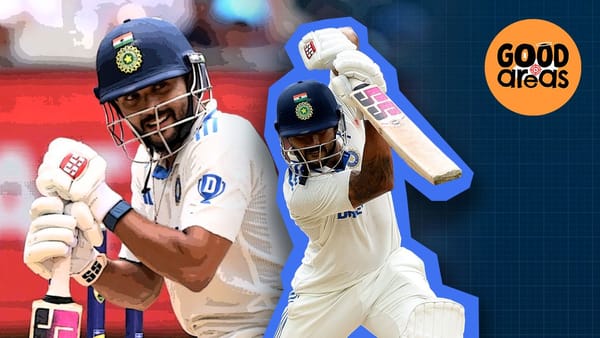The second Test for better or worse
A look at how being really bad in one Test doesn't mean you will be in the next one.
India didn't collapse for 36 in the first Test. They lost 17 wickets for 92 runs. Their captain was going home and their most dependable bowler. Oh, and another frontline bowler is still out injured.
The only thing that went there way was Ravi Jadeja was available, in every other way it was a complete shit show. They interviewed me on UK radio about the series, and one question I got was, "Will Australia win 4-0, now". I get it, even those of us who don't believe in sporting momentum, understand 92 for 17. That's a punch in the throat on a wintry morning.
And you can't lose Kohli's batting from that and feel any better about life. For those momentumhawks out there, this series was done.
But the reason cricket momentum doesn't matter that much is that wins come because one team has played better, is better, or has had the better of the conditions. Let's call this the triangle of better.
Better one - playing better
In a four Test series you have 20 days of cricket to be scheduled. We take them one Test at a time, but rarely is one team playing better than the other for all five days. If you time that right, like say the end of a Test you're hanging onto, like Australia at Adelaide, you can win the Test. That doesn't mean you are the better team all the time. In Australia's case, there were plenty of reasons to worry coming out of the first match. But at an important point, they played fantastic crazy googoo cricket, which allowed them a big win. There are currently many teams in world cricket who are roughly as good as each other. There's no clear number one team, and all it takes is one team to take catches while the other one doesn't for a comfortable win between two even sides. The thing about playing better than your opposition to win is there will be times when a team roughly as good will outperform you.
Better two - you're better
If your team is clearly superior to the opposition, having won the previous Test can help, but chances are you will win a long series, regardless. Anyone can be surprised in a match, have a comedy collapse, or just run into an excellent batting effort. But match after match, those things are unlikely. Tests are set up to ensure the quality rises to the top; in other sports you get more sporadic results from game to game. Test cricket is random, but rarely in who wins. Now all of this is on a sliding scale, you might only be slightly better, or massively so. And also you might be superior in one discipline, but not both. Much of what we look at as having the edge mentally, or possessing momentum from the last game, is just one team with seven functioning batsmen and four good bowling options. While the opposition is trying to put a batting line up together using spit and duct tape.
Better three - better conditions
The pitch doesn't give a shit about who is better, or how they are playing. It is a collection of living organisms fed on animal defecation, and it's going to do what it does. I've seen pitches randomly start seaming on day three, yet by day four are a road. Morning sessions that are impossible and afternoons that are delightful. Not to mention the ball only swings for one team, regardless of the immaculate seam position of their opposition. One team manages to only bat when it's overcast, and the other sees nothing but sun. It goes on and on; Test cricket is a conditions based sport. It is possible to play well in a Test, but just keep coming up against the wicket and lose.
So where do these Tests count on the triangle of better. Neither team is vastly superior to each other, and while conditions have probably played a small part in both sides winning, it hasn't been a major part. No, this series so far has come down to when the fact that both teams have talent and flaws.
India should have lost this second Test, an unstable team, that lost batting, took a gamble on their all rounder, and had to bring in an inexperienced bowler. Australia came into this Test missing David Warner and had just won a Test by eight wickets. But there's no doubt this Australian team is frangible. They win a lot of Tests because their bowling is Mount Rushmore worthy. But their batting still had one makeshift opener with a guy who needs a lie down on a beach. Smith may not need a hard reset, but a soft reboot could help. And then you have a guy in his second Test, a wicketkeeper who can't make hundreds and Travis Head's various issues. Basically, their batting has been Marnus.
India has Rahane, Agarwal and Pujara in their top four. It's a little shaky after that, as Adelaide proved. But if Jadeja can keep up with nagging runs, they can possess a five-man bowling unit with two hall of fame spin options, Jasprit Bumrah, and two warm bodies of their choosing. They lost a nasty Test in Adelaide, but it was one they were bossing for two innings, even after their first collapse. Even allowing for their many injuries and withdrawals, there is a lot of talent here, so it was never impossible they would win a Test.
And even though they have essentially pulled off a 16 wicket turnaround with a frontline bowler only delivering 3.3 overs in their second innings. It's an extraordinary effort, but perhaps not as big a surprise. That doesn't mean India shouldn't be ecstatic, they were lining up obstacles to this series. And while teams can bounce back from the 36 (92) thing, it's still an achievement to bat as they did the very next time Australia bowled that well, which was the following innings.
But I remember a smart athlete years ago trying to explain momentum. He'd mentioned it in a tweet and was criticized by sports fans like me questioning his use of the word. He said that sporting momentum was largely nonsense, but often athletes had just started using it instead of the word confidence.
Going into the third Test, India has confidence on their side. But Australia still has Pat Cummins and his merry band of cold-blooded assassins. They had them in the second Test too, but India's bowlers did just as well, and their batsmen played one quality innings.
Or to put it another way, India were better, and Australia were worse.




